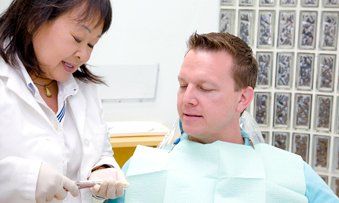Oral Cancer Exam
Oral Cancer Exam
According to American Dental Association, 42,000 Americans will be diagnosed with Oral and Throat cancer this year.
The 5 year survival rate for those diagnosed will be slightly more than 64%. The reason the survival Factors that contributes to the oral cancer are smoking and excessive drinking. More recently the Human papillomavirus have been associated with cancer of the oropharyngeal region that is part of the throat at the base of the mouth. Regular visits to your dentist can improve chances that any suspicious changes will be caught early on. Your dentist can see or feel any tissue changes. Early diagnose will allow the cancer to be treated more easily.
Oral cancer: What you need to know
Oral cancer is the sixth most common cancer, accounting for 30,000 newly diagnosed cases each year – and 8,000 deaths.1 If not diagnosed and treated in its early stages, oral cancer can spread, leading to chronic pain, loss of function, facial and oral disfigurement and even death.
Who gets oral cancer?
Anyone can get oral cancer. Heavy drinkers and people who smoke or use other tobacco products are at higher risk. Though it is most common in people over age 50, new research indicates that younger people may be developing oral cancers related to human papillomavirus (HPV).
Early detection can save
The good news? The earlier oral cancer is detected and treated, the better the survival rate – which is just one of the many reasons you should visit your dentist regularly. Twice-yearly dental checkups are typically covered with no or a low deductible under most Delta Dental plans.
As part of the exam, your dentist will check for oral cancer indicators, including feeling for lumps or irregular tissue in your mouth, head and neck. A biopsy will be recommended if anything seems concerning or out of the ordinary.
Warning signs
You should also perform your own self-examinations to check for early warning signs. Contact your dentist immediately if you notice any of the following symptoms:
Sores that last longer than two weeks
Swelling, growths or lumps anywhere in or near your mouth or neck
White or red patches in your mouth or on your lips
Repeated bleeding from the mouth or throat
Difficulty swallowing or persistent hoarseness
Some information courtesy of the Centers for Disease Control and Prevention, Division of Oral Health, National Center for Chronic Disease Prevention and Health Promotion.



